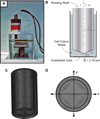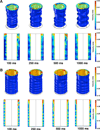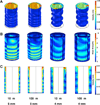Analysis of a high-throughput cone-and-plate apparatus for the application of defined spatiotemporal flow to cultured cells
- PMID: 23280552
- PMCID: PMC4589279
- DOI: 10.1002/bit.24823
Analysis of a high-throughput cone-and-plate apparatus for the application of defined spatiotemporal flow to cultured cells
Abstract
The shear stresses derived from blood flow regulate many aspects of vascular and immunobiology. In vitro studies on the shear stress-mediated mechanobiology of endothelial cells have been carried out using systems analogous to the cone-and-plate viscometer in which a rotating, low-angle cone applies fluid shear stress to cells grown on an underlying, flat culture surface. We recently developed a device that could perform high-throughput studies on shear-mediated mechanobiology through the rotation of cone-tipped shafts in a standard 96-well culture plate. Here, we present a model of the three-dimensional flow within the culture wells with a rotating, cone-tipped shaft. Using this model we examined the effects of modifying the design parameters of the system to allow the device to create a variety of flow profiles. We first examined the case of steady-state flow with the shaft rotating at constant angular velocity. By varying the angular velocity and distance of the cone from the underlying plate we were able to create flow profiles with controlled shear stress gradients in the radial direction within the plate. These findings indicate that both linear and non-linear spatial distributions in shear stress can be created across the bottom of the culture plate. In the transition and "parallel shaft" regions of the system, the angular velocities needed to provide high levels of physiological shear stress (5 Pa) created intermediate Reynolds number Taylor-Couette flow. In some cases, this led to the development of a flow regime in which stable helical vortices were created within the well. We also examined the system under oscillatory and pulsatile motion of the shaft and demonstrated minimal time lag between the rotation of the cone and the shear stress on the cell culture surface.
Copyright © 2013 Wiley Periodicals, Inc.
Figures









References
-
- Bao X, Lu C, Frangos JA. Temporal gradient in shear but not steady shear stress induces PDGF-A and MCP-1 expression in endothelial cells: Role of NO, NF kappa B, and egr-1. Arterioscler Thromb Vasc Biol. 1999;19(4):996–1003. - PubMed
-
- Blackman BR, Garcia-Cardena G, Gimbrone MA., Jr A new in vitro model to evaluate differential responses of endothelial cells to simulated arterial shear stress waveforms. J Biomech Eng. 2002;124(4):397–407. - PubMed
-
- Buschmann MH, Dieterich P, Adams NA, Schnittler HJ. Analysis of flow in a cone-and-plate apparatus with respect to spatial and temporal effects on endothelial cells. Biotechnol Bioeng. 2005;89(5):493–502. - PubMed
-
- Carlson DR, Widnall SE, Peeters MF. A flow-visualization study of transition in plane Poiseuille flow. J Fluid Mech. 1982;121:487–505.
-
- Chatzizisis YS, Baker AB, Sukhova GK, Koskinas KC, Papafaklis MI, Beigel R, Jonas M, Coskun AU, Stone BV, Maynard C, Shi GP, Libby P, Feldman CL, Edelman ER, Stone PH. Augmented expression and activity of extracellular matrix-degrading enzymes in regions of low endothelial shear stress colocalize with coronary atheromata with thin fibrous caps in pigs. Circulation. 2011;123(6):621–630. - PMC - PubMed
MeSH terms
Grants and funding
LinkOut - more resources
Full Text Sources
Other Literature Sources

